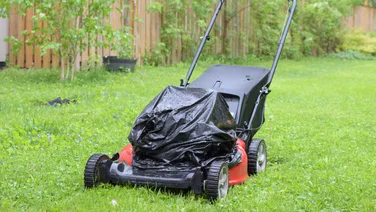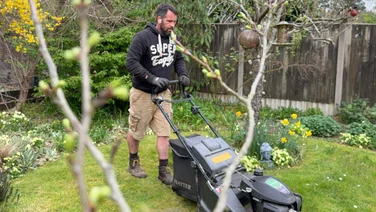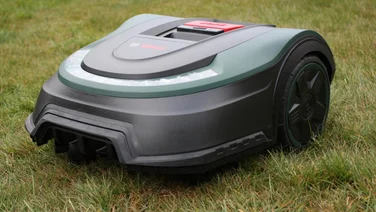To help us provide you with free impartial advice, we may earn a commission if you buy through links on our site. Learn more









- Robust
- Supports gardens up to 625m²
- Zone control and spot mowing
- Expensive
- No app for remote control
- Leaves edges untrimmed
Just when you thought robot lawn mowers were getting overly sophisticated, along comes the Gtech RLM50. While many of its similarly priced rivals come with smartphone apps that control when they go out and sensors that stop them from bumping into things (or even detecting when they get to the edge of your lawn), the RLM50 is gloriously old school.
Everything you need to control the robot is available from its relatively basic onboard control panel. It’s designed to head out into your garden guided only by its perimeter wire, turning in a random direction when it hits a border. However, despite simple software and no requirement to connect it to the internet, it still has a few features that many of the best robot lawn mowers lack, such as spot mowing and zone control.
Gtech RLM50 review: What do you get for the money?
Given what I’ve said above about its comparatively limited features, it might surprise you that the Gtech RLM50 costs £900. In its defence, however, cheaper rivals with similar feature sets tend to be flimsier and aren’t rated to cover such a lot of ground. In contrast, the RLM50 is robustly built and has been rated by Gtech to cover gardens of up to 625m².
It comes with everything you need to set it up. As well as the mower itself, there’s the charging station, 7m of cabling to connect it to a wall socket, 100m of perimeter wire and a well-packed bag of pegs for pegging it all down. There are also some welcome extras: six spare cutting blades, four wire-fixing splicers and an Allen key to screw in the special pegs that fix the charging station to your lawn.









The mower itself is about average size at 350 x 520 x 260mm (WDH) and weighs 8.7kg. Its cutting blade has a diameter of 18cm and is positioned in the centre of the base, so there’s a gap of 8.5cm between the limit of the cutting blades and the two outer edges of the mower.
Gtech recommends laying your wire 35cm from the edge of the lawn and doesn’t mention in the manual whether you can reduce this if the edge is relatively safe, such as butting up to paving that’s sunk to the same level as the lawn, rather than a vertical dropped edge into a flower bed. If you follow Gtech’s advice, you’ll get an unmowed border of 26cm around the edge, which you’ll need to tackle occasionally with a regular mower, trimmer or strimmer.
The cutting blade can be set between 25mm and 55mm off the ground in 5mm increments, selectable using a dial that’s hidden under a panel on the top of the mower. A second panel is opened using the stop button, which lets you access the LCD screen and nine-button control panel below.









Control of the robot is managed exclusively through this panel, with no requirement to resort to a smartphone app in order to get the most out of the device. If you’re not a fan of phone apps you’ll relish being able to manage the mower from here. However, it makes setting the various functions more fiddly, as you have to use the up, down, left and right buttons to navigate text menus and set operating times.
The 22v battery takes around two hours to charge and can run for up to an hour and a half. The battery compartment is accessed through the base of the mower, and is accessible by unscrewing six Phillips screws, should you ever need to replace it.
READ NEXT: The best grass seed mixes for gardens and lawns
Gtech RLM50 review: How easy is it to set up?
Most robot mowers with a perimeter wire are mildly inconvenient to set up, and the Gtech RLM50 is no different. It’s not technically difficult but involves laying wire around the edge of your lawn, so requires a fair amount of crawling about on your hands and knees.
The charging base needs to be within 7m of an external electrical socket and have at least 2m of straight wire leading onto its base from the front. The wire should be laid 35cm away from the edge of your garden, and there’s a convenient cardboard template included in the box to help you measure it.









You can peg the wire down at 1m intervals, or more regularly if creating a curve to go around a corner or cover uneven ground. It would be even better to bury the wire, which you can do with a manual edging tool, though your lawn will grow over a pegged wire in time. All this is a bit of a palaver but it only needs to be done once.
Unlike most smartphone-operated mowers, setting up the RLM50 will also see you on your hands and knees, as you need to use the buttons on the control panel to set the mower going.
READ NEXT: Our favourite grass trimmers
Gtech RLM50 review: How well does it mow the lawn?
The Gtech RLM50 uses the same basic cutting mechanism as every robot lawn mower we’ve tested to date: a spinning disc with a trio of razor-like blades attached, which slice the top off of any blade of grass unfortunate enough to be growing in its path. It’s a simple but effective system that, if you send your robot out regularly enough, can keep your lawn manicured, while the clippings are kept small and simply mulch into the lawn.
I found that it provided my lawn with a very decent trim. The robust build seemed capable of tackling all the undulations and other problem areas that my lawn presents, rolling smoothly and capably over them all. Even at its lowest cutting setting, I couldn’t find anywhere where it scalped my lawn.









One of the ways it can manage a relatively large area is its ability to set mowing zones, which can ensure it spends time in distant corners of your garden. To set this up you have to enter a series of numbers for each zone, namely how far around the perimeter it should travel before breaking off, and what percentage of the mowing time you want the RLM50 to spend there before moving on.
In small, regularly shaped gardens, this isn’t particularly useful. However, in larger, sectionalised gardens, with narrow connecting areas that the random mowing pattern may find difficult to channel its way down, it’s an essential way to ensure that distant corners get the attention they need.
If you still struggle to get the mower to hit a certain section, it comes with a spot mow option. This is a simple case of dropping the mower in the centre of the problem area and choosing the spot mow option from the menu. It starts by rotating on the spot, then cuts in an increasingly wide spiral. Once the area is covered, with a radius of about 2m, the robot stops and needs user input to carry on mowing.
The last option is scheduling. This is the one area where I think the mower’s lack of app control hampers its ability to do exactly what you want. All you can do here is set up a daily set of start and finish times.









There’s a setting for each day of the week, so you can set it up to work harder on days when you don’t use the garden or keep it inactive at times when you use it more, such as at the weekend. Setting the options is a bit like setting a digital alarm clock or an oven timer – you have to use left and right buttons to select the day, and then up and down buttons to scroll through hours and minutes. The saving grace is that, on the whole, you aren’t going to have to do this very often.
It’s not as feature-rich as the average app-controlled mower, though. Even the significantly cheaper Yard Force EasyMow 260B offers more flexibility to its scheduling, letting you set up two individual operating slots for each day, giving the mower the opportunity to have a lunch break. I was a bit disappointed by the relative inflexibility of the RLM50’s scheduling given its price.
Gtech RLM50 review: Should you buy it?
For its relatively short list of features, the Gtech RLM50 looks expensive, and I’d expect more technology to be thrown at a mower of this price. Without a smartphone app to help you control it, it feels quaintly old-fashioned to be plugging scheduling times and perimeter coordinates into the device using up, down, left and right buttons.
However, smartphone apps come with their downsides, too, and if you’d rather not have to reach for your phone every time you want to tweak a setting, then this is a good mower that’s perfectly capable to operate alone. It makes sense to control features such as spot mowing from the device itself rather than an app, too.









For this kind of price, though, you can get equally good robot mowers with some interesting extra functions. For example, the Bosch Indego S+ 500 is only slightly more expensive but can cut your lawn in a regulated pattern, making it faster and smarter than the RLM50.
There are also mowers that will leave less of an uncut gap around the edge of your lawn. The Worx Landroid M500 Plus WR165E still leaves some uncut space, but its offset cutting blade takes it closer to the outside edge of the mower, reducing the width of these uncut borders.
If you’d prefer not to have to lay a boundary wire and would prefer a drop-and-mow alternative, the LawnMaster VBRM16 is a treat. This uses cameras on the front of the mower to detect where the lawn edge is, so you can start cutting your grass without having to worry about charging stations and perimeter wire, though you have to manually put it away when it’s finished cutting.
Lastly, for a cheaper option with a surprisingly similar set of features, consider the Yard Force EasyMow 260B. Although it’s half the price of the RLM50 and has a more basic control panel, it comes with a smartphone app that connects via Bluetooth, which can be used to fine-tune exactly when the mower goes out.






